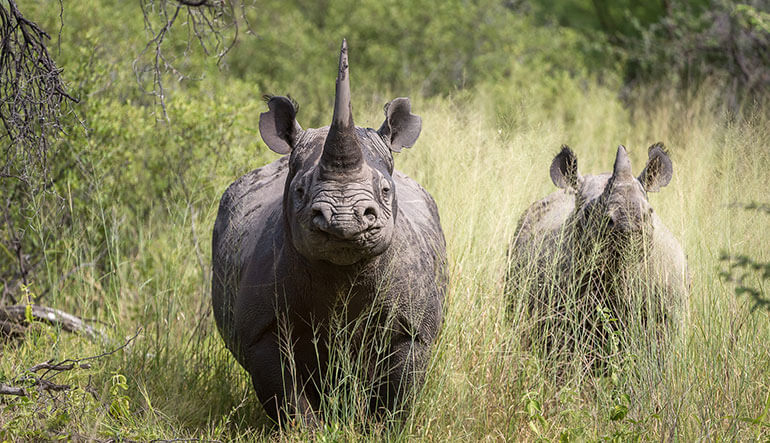Rhinos have walked the planet for 50 million years. Even though rhinos are one of the most iconic animals in the world, many people don’t know enough about this ancient species.
The rhino forms part of the notorious African Big Five, famous for being the most dangerous and difficult animals to hunt.
From walking safaris to water safaris, there’s just nothing like viewing beautiful wildlife in the African savannah.
We’ve shared some of the most interesting rhino facts so that you can learn a bit more about this endangered animal before witnessing them in the African bush.
Rhino Facts
The word rhinoceros is a combination of 2 Greek words; “rhino”, meaning nose, and “ceros” meaning horn. The collective word for a group of rhinos is a “crash”.
There are five species of rhinos.
- White rhino (found in Africa)
- Black rhino (found in Africa)
- Indian rhino (native to Southeast Asia)
- Javan rhino (native to Southeast Asia)
- Sumatran rhino (native to Southeast Asia)
Rhino horns are made of keratin. Keratin is the same fibre that is found in hair, fingernails as well as pangolin scales. Rhino horn is not bone, but rather a compacted mass on the nose that continues to grow throughout the animals lifetime. When rhinos are murdered, their horns are sold as trophies, or more often ground into a powder and used in traditional Chinese medicine.
Rhinos and oxpecker birds have a symbiotic relationship. In Swahili, oxpeckers are the “askari was kifuru” – which means the rhino’s guard. The oxpecker eats the ectoparasites that sit on the rhinos hide, keeping the Rhinoceros free of ticks and the oxpecker fed. The oxpecker also acts as an alarm for the rhino, creating commotion when danger is near.
Another fun rhino fact is that they love wallowing in mud. Rhinos have thick, sensitive skin that can react to sunburns and insect bites. By covering themselves with wet mud and letting it dry, the clay acts as a sunblock and protects their skin from other insects. Rhinos rub their bodies against tree trunks and rocks to remove ectoparasites which have become stuck in the dry mud on their skin.
Each rhinoceros has a unique smell and can be identified by other rhinos. The dung of a baby rhino smells different than that of an adult, and a female’s dung smells different to a male’s. Rhinos communicate by using piles of dung to leave messages for other rhinos. Male and female rhinos mark their territories with dung heaps called “middens” to communicate their whereabouts and reproductive condition.
The difference between the white and the black rhino
Surprisingly, the difference between the white and black rhino does not come from their colour. Both are, in fact, grey.
The white rhino derives from the word “wyd” in Afrikaans, which means “wide”, and describes its wide-squared mouth. The white rhino has a large flat upper lip that is designed to graze grass. You will hardly see a white rhino wandering around carrying its head high, as it prefers to walk with its mouth lowered to the ground
As the white rhino’s nose and eyes are always on the ground, the animal depends on their ears for their overall awareness and safety. As a result, they have long, tubular ears that funnel sound into them, and turn independently like little satellites.
Unlike the white rhino, the black rhino eats trees, leaves, bushes and branches. Black rhinos have pointed lips which are used to grab hold of the spiky shoots of trees.
The black rhino has a shorter body with a deep arch in its back. It carries its head high to reach leaves and branches. With this, its ears, eyes and nose are high in the air most of the time. As a result, its ears are much smaller and rounder in shape.
When it comes to behaviour, black rhinos have always had a reputation for being more aggressive and inquisitive than the white rhino, which is typically a little more placid.
Rhino poaching in Africa
Even though rhinos live in a habitat prowled by threatening predators such as lions, leopards, cheetahs, hyenas and other dangerous animals, humans are the biggest threat to rhinos.
Rhino poaching is the act of illegally and ruthlessly killing wild rhinos for their horns and other body parts. These are used as trophies and decorations or are sold in the traditional Chinese medicine market.
In the past five years, rhino poaching has increased by 900%. Despite the facts, most people around the world do not realise how endangered the rhinoceros is.
Would you like to support conservation efforts to defend the rhinos from poachers? Donate to anti-poaching campaigns that are helping to save the rhinoceros as well as boycotting the purchase of any products made from rhino horn. Take a look at the following organisations:
Learn more about animal conservation in Africa and how to help protect our endangered species in our post The 5 Most Endangered Animals in Africa.
We hope that you enjoyed reading this post on our beloved rhinos. If you would like to view these ancient animals in the wild, book a bespoke safari to the captivating continent of Africa with us.
If you enjoyed learning about the rhino, find out more about Africa’s animals by reading our interesting reading facts about the elephant, lion, leopard, penguin and cheetah.


